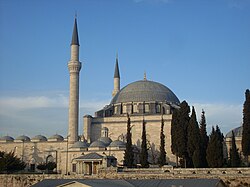Yavuz Selim Mosque
| Yavuz Sultan Selim Mosque Selim I Mosque |
|
|---|---|

Yavuz Selim Mosque in Istanbul
|
|
| Basic information | |
| Location | Istanbul, Turkey |
| Geographic coordinates | 41°01′35.6″N 28°57′4.8″E / 41.026556°N 28.951333°ECoordinates: 41°01′35.6″N 28°57′4.8″E / 41.026556°N 28.951333°E |
| Affiliation | Islam |
| Architectural description | |
| Architectural type | Mosque |
| Groundbreaking | 1520/21 |
| Completed | 1527/28 |
| Specifications | |
| Height (max) | 32,5 m |
| Dome dia. (outer) | 24,5 m |
| Minaret(s) | 2 |
| Minaret height | 45 m? |
| Materials | cut stone, granite, marble |
The Yavuz Selim Mosque, also known as the Selim I Mosque and the Yavuz Sultan Selim Mosque (Turkish: Yavuz Selim Camii) is a 16th-century Ottoman imperial mosque located at the top of the 5th Hill of Istanbul, Turkey, in the neighborhood of Çukurbostan, overlooking the Golden Horn. Its size and geographic position make it a familiar landmark on the Istanbul skyline.
The Yavuz Selim Mosque is the second oldest extant imperial mosque in Istanbul. It was commissioned by the Ottoman sultan Suleiman the Magnificent in memory of his father Selim I who died in 1520. The architect was Alaüddin (Acem Alisi). The mosque was completed in 1527/8. Attempts have been made to associate the structure with the famous imperial architect Mimar Sinan, but there is no supporting documentary evidence, and the date of the mosque is too early. However, one of the türbe in the garden of the mosque is a work of Sinan (see below).
The mosque was built on a terrace overlooking the Cistern of Aspar, the largest of the three Roman reservoirs in Constantinople. The large courtyard (avlu) has a colonnaded portico with columns of various types of marble and granite. The mosque has panels of coloured tiles that were decorated using the cuerda seca technique. These are similar to the lunette panels above the windows on either side of the fireplace in the Circumcision Room (Sünnet Odası) of the Topkapı Palace and were almost certainly made by the same group of Iranian craftsmen working for the Ottoman court. The mosque is flanked by twin minarets.
...
Wikipedia
